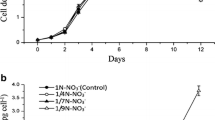Abstract
The extracellular polysaccharides (ECPS) released by diatoms have significant roles in marine ecosystems and have potential applications including drug-discovery and biopharmaceutical precursors. In this study, matrix-assisted laser desorption/ionization time-of-flight mass spectrometry (MALDI-TOF MS) technology was used in the structural analysis of the ECPS released by Thalassiosira pseudonana (Bacillariophyta). Three different deproteinization methods, the Sevag method, the trichloroacetic acid (TCA) method, and the enzymolysis method, were compared in the purification of ECPS. Our results suggested that TCA was the best deproteinization method among the three methods for subsequent MALDI-TOF MS investigation because of its high ECPS yield, protein removal ability and reliable MALDI-TOF MS fingerprint. The degree of polymerization (d.p.) profiles, the molecular weight of the ECPS and the distribution pattern of the polymers with different molecular mass were described from the MALDI-TOF MS spectra. This work represents the whole-level composition of the ECPS released by the diatom and has improved our knowledge of the structural characterization of ECPS.







Similar content being viewed by others
References
Azam F, Smith DC (1991) Bacterial influence on the variability in the ocean’s biogeochemical state: a mechanistic view. In: Demers S (ed) Particle analysis in oceanography. NATO ASI Series G 27, Springer-Verlag, Berlin, pp 213–236
Barbarino E, Lourenço SO (2005) An evaluation of methods for extraction and quantification of protein from marine macro- and microalgae. J Appl Phycol 17:447–460
Bradford MM (1976) A rapid and sensitive method for the quantitation of microgram quantities of protein utilizing the principle of protein-dye binding. Anal Biochem 72:248–254
Beech IB, Sunner JA, Hiraoka K (2005) Microbe–surface interactions in biofouling and biocorrosion processes. Int Microbiol 8:157–168
Chen Y, Xie M, Li WJ, Zhang H, Nie SP, Wang YX, Li C (2012) An effective method for deproteinization of bioactive polysaccharides extracted from Lingzhi (Ganoderma atrum). Food Sci Biotechnol 21:191–198
Chizhov AO, Dell A, Morris HR, Reason AJ, Haslam SM, McDowell RA, Chizhov OS, Usov AI (1998) Structural analysis of laminarans by MALDI and FAB mass spectrometry. Carbohydr Res 310:203–210
de Brouwer JFC, Stal LJ (2002) Daily fluctuations of exopolymers in cultures of the benthic diatoms Cylindrotheca closterium and Nitzschia sp (Bacillariophyceae). J Phycol 38:464–472
Dubois M, Gilles KA, Hamilton JK, Rebers PA, Smith F (1956) Colorimetric method for determination of sugars and related substances. Anal Chem 28:350–356
Harvey DJ, Bateman RH, Bordoli RS, Tyldesley R (2000) Ionisation and fragmentation of complex glycans with a quadrupole time-of- flight mass spectrometer fitted with a matrix-assisted laser desorption∕ionistion ion source. Rapid Commun Mass Spectrom 14:2135–2142
Harvey DJ (1999) Matrix-assisted laser desorption / ionization mass spectrometry of carbohydrates. Mass Spectrom Rev 18:349–451
Haynes K, Hofmann TA, Smith CJ, Ball AS, Underwood GJC, Osborn AM (2007) Diatom-derived carbohydrates as factors affecting bacterial community composition in estuarine sediments. Appl Environ Microbiol 73(19):6112–6124
Hoagland KD, Rosowski JR, Greta MR, Roemer SC (1993) Diatom extracellular polymeric substances: function, fine structure, chemistry and physiology. J Phycol 29:537–566
Karas M, Bachmann D, Bahr U, Hillenkamp F (1987) Matrix-assisted ultraviolet laser desorption of non-volatile compounds. Int J Mass Spectrom Ion Process 78:53–68
Karas M, Hillenkamp F (1988) Laser desorption ionization of proteins with molecular masses exceeding 10000 daltons. Anal Chem 60:2299–2301
KiØrboe TJ, Hansen LS, Alldredge AL, Jackson GA, Passow U, Dam HG, Drapeau DT, Waite A, Garcia C (1996) Sedimentation of phytoplankton during a spring bloom. Rates and mechanisms. J Mar Res 54:1123–1148
Lee FW, Ho KC, Lo SC (2008) Rapid identification of dinoflagellates using protein profiling with matrix-assisted laser desorption/ionization mass spectrometry. Harmful Algae 7:551–559
Lee JB, Hayashi K, Hirata M, Kuroda E, Suzuki E, Kubo Y, Hayashi T (2006) Antiviral sulfated polysaccharide from Navicula directa, a diatom collected from deep-sea water in Toyama Bay. Biol Pharm Bull 29:2135–2139
Magaletti E, Urbani R, Sist P, Ferrari CR, Cicero AM (2004) Abundance and chemical characterization of extracellular carbohydrates released by the marine diatom Cylindrotheca fusiformis under N- and P- limitation. Eur J Phycol 39:133–142
Passow U, Alldredge AL (1995) Aggregation of a diatom bloom in a mesocosm: the role of transparent exopolymer particles (TEP). Deep-Sea Res II 42:99–110
Passow U, Alldredge AL, Logan BE (1994) The role of particulate carbohydrate exudates in the flocculation of diatom blooms. Deep-Sea Res I 41:335–357
Pete R, Davidson K, Hart MC, Gutierrez T, Miller AEJ (2010) Diatom derived dissolved organic matter as a driver of bacterial productivity: the role of nutrient limitation. J Exp Mar Biol Ecol 391:20–26
Shevchenko NM, Burtseva YV, Zvyagintseva TN, Makaréva TN, Sergeeva OS, Zakharenko AM, Isakov VV, Thi Linh N, Xuan Hoa N, Minh Ly B, Huen P (2009) Polysaccharides and sterols from green algae Caulerpa lentillifera and C. sertularioides. Chem Nat Comp 45:1–5
Sandford PA, Baird J (1983) Industrial utilization of polysaccharides. In: Aspinall GO (ed) The polysaccharides. Academic, London, pp 411–490
Urbani R, Magaletti E, Sist P, Cicero AM (2005) Extracellular carbohydrates released by the marine diatoms Cylindrotheca closterium, Thalassiosira pseudonana and Skeletonema costatum: effect of P-depletion and growth status. Sci Total Environ 353:300–306
Acknowledgments
This work was supported by the National Natural Science Foundation of China under grant numbers 40876079, 41076080, the national 973 project under grant number 2011CB200901, the Fujian Province Science Fund for Distinguished University Young Scholars (Grant No. JA10001), and the Natural Science Foundation of Fujian Province of China under grant number 2008J0139. The authors wish to thank Dr. Xinyue Peng for his suggestions on preparing the manuscript.
Author information
Authors and Affiliations
Corresponding author
Rights and permissions
About this article
Cite this article
Liang, JR., Ai, XX., Gao, YH. et al. MALDI-TOF MS analysis of the extracellular polysaccharides released by the diatom Thalassiosira pseudonana . J Appl Phycol 25, 477–484 (2013). https://doi.org/10.1007/s10811-012-9881-6
Received:
Revised:
Accepted:
Published:
Issue Date:
DOI: https://doi.org/10.1007/s10811-012-9881-6




